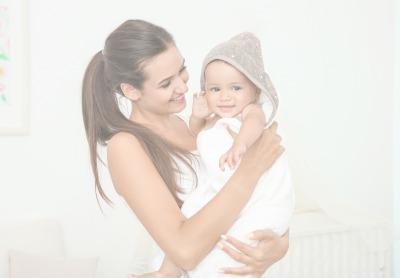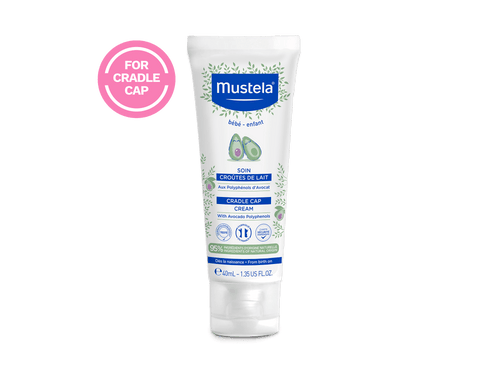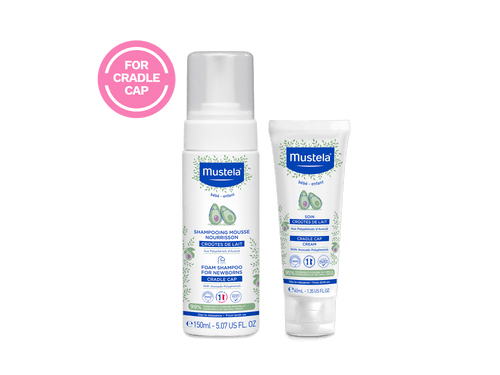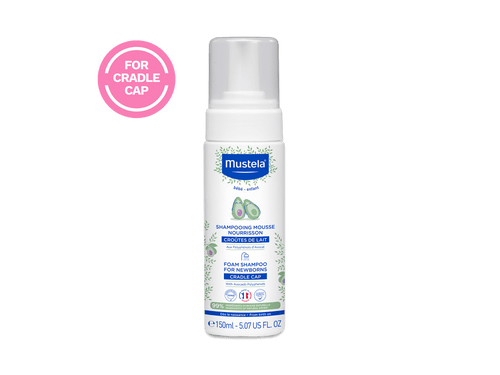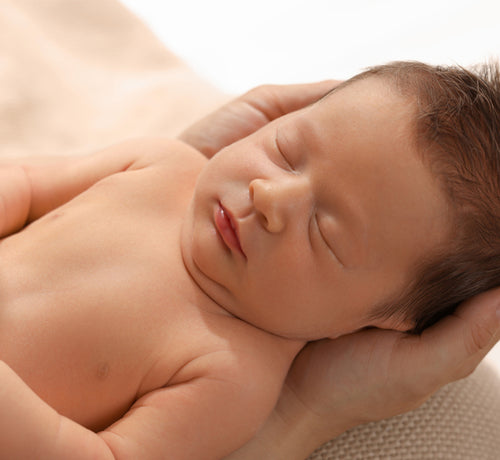Babies have soft, delicate skin. This means your baby’s skin is easily irritated and prone to dryness, including the skin on their head and scalp. If your little one has flaky skin on their head, you’re probably wondering if it’s a sign of dry scalp or cradle cap.
It’s not uncommon for a baby to develop one or both of these conditions. But how are they different? And, more importantly, how can you care for your little one when they have baby dry scalp or cradle cap?
In this post, the baby experts at Mustela will answer both of these questions and more.

What’s The Difference Between Baby Dry Scalp And Cradle Cap?
Dry scalp and cradle cap are similar conditions, so it can be tough to tell them apart. At their core, both stem from your little bundle of joy having dry skin on their head. So what’s the difference between the two?
In short, dry scalp is just that: dry, flaky skin on your little one’s head. It’s essentially a case of baby dandruff. The skin may appear red or yellowish and feel scaly or rough to the touch. Dead skin may flake off of your baby’s dry scalp.
Cradle cap, on the other hand, begins with a dry scalp but has progressed slightly further. Rather than just flaky, scaly skin, cradle cap is characterized by rough, crusty bumps that protrude from your baby’s scalp. Whereas baby dry scalp will feel dry, cradle cap will actually feel oily to the touch.

Let’s talk a bit more in-depth about both dry scalp and cradle cap and go over the causes and symptoms of each
All About Dry Scalp
Dry skin is perfectly normal for adults, toddlers, and infants alike. Sometimes, that dry skin can develop on your or your baby’s scalp.
Causes
What causes your baby’s scalp to become dry? There are several factors that may contribute to baby dry scalp, including:
- Harsh weather (very hot or very cold temperatures, powerful winds, etc.)
- Sunburn on your baby’s head
- Long baths or baths that are too hot
- Shampoos and soaps that are too strong for your baby’s skin
- Accidentally failing to rinse all of the shampoo out of your child’s hair
Any combination of these factors may cause dry scalp.
Symptoms
You’ll be able to identify the condition by the following symptoms:
- Dry skin on your baby’s head that may be flaky, scaly, or peeling
- Reddish, pinkish, yellowish, or brownish discoloration on your little one’s scalp
- Slight inflammation
- Signs of discomfort, such as crying or squirming more than usual
If your little one is showing these symptoms, it is very likely that they have dry scalp.

All About Cradle Cap
Like eczema or baby acne, cradle cap is an extremely common skin condition. In fact, some research estimates that as many as 70 percent of infants develop cradle cap before three months of age.
Despite its prevalence, researchers aren’t exactly sure what causes cradle cap. There are several possibilities.
@ftanks58 @MustelaUSA Sent us the most amazing products! This cradle cap duo is a game changer! ##MustelaMoms ##MyMustelaMoments ##momsoftiktok ##babiesoftiktok
♬ ily (i love you baby) - Surf Mesa
Causes
One theory is that cradle cap is the result of a problem with the sebaceous glands on your child’s head. Sebaceous glands are responsible for releasing sebum, a natural oil the human body secretes to keep skin protected and moisturized.
If excess sebum is released, it can harden and form into small clusters. Alternatively, if sebaceous glands become clogged, the sebum released may solidify and build up on top of your little one’s pores.
A second possible cause of cradle cap is a strain of yeast called Malassezia. This particular type of yeast is naturally found on living human skin, but it may sometimes cause skin conditions or infections. This is especially true if the Malassezia begin to colonize within your baby’s sebaceous glands.
While we don’t know what exactly causes cradle cap, we do know that it is not a hygiene issue. Some parents may believe cradle cap is related to poor hygiene or inadequate bathing, but this is simply not the case.
A few other important points about cradle cap: it is not contagious, and it is not painful for your baby. It may be unsightly, but it will not spread and your baby is probably not in any discomfort.
Symptoms
You can identify cradle cap by these common symptoms:
- Small patches of crusty, oily skin that feel both greasy and rough
- Spots appearing mostly on your baby’s head, neck, and/or face
- The rough, oily patches being raised from your child’s skin (not flat)
If your baby is showing these symptoms, they probably have a case of cradle cap. But don’t worry. There are plenty of easy and effective ways to treat it.
How To Treat Your Baby’s Dry Scalp And Cradle Cap
Fortunately, the same treatments are effective in caring for both cradle cap and baby dry scalp. Here are seven easy and effective treatments for your little one’s dry scalp or cradle cap.
1) Bathe Your Baby Regularly

While hygiene is definitely not a cause of dry scalp or cradle cap, baths are still essential for keeping your little one’s skin healthy. Daily baths are helpful when caring for your child’s sensitive scalp area.
If you prefer, however, you can bathe your child every other day instead of every day. As long as you’re maintaining an adequate daily hygiene routine and changing your baby’s diapers the right way, three to four baths per week is sufficient.
2) Use Micellar Water In-Between Baths
To keep your baby’s skin extra clean on days they go without a bath, use a safe and baby-friendly micellar water, like Mustela’s Organic Micellar Water with Olive Oil and Aloe.
It’s perfect for traveling and super easy to use! Simply apply it to your baby’s skin — their face, body, and diaper area, too — using a soft cloth, diaper wipe, or cotton pad. Then pat them dry. There’s no need to rinse!
Our micellar water is made with 99.7% naturally derived ingredients, including organic aloe vera and organic olive oil to protect, soften, and soothe your baby’s kissable skin. And it cleanses your little one’s skin without stripping it of its natural oils.
3) Keep Baths Short
Long baths can remove sebum from your baby’s skin and scalp, leaving them vulnerable to dehydration and dryness. To care for your baby’s dry scalp or cradle cap, limit baths to 10 minutes or less.
Remember that your little one can still have loads of fun even if it’s a short bath. With Mustela’s Multi-Sensory Bubble Bath, you can keep them happy and entertained in a bath full of bubbles!
4) Make Sure Bath Water Is The Right Temperature
Bath water should be approximately the same as your baby’s body temperature: 98.6 degrees Fahrenheit. If it’s one or two degrees above or below, that’s completely fine.
This water temperature will be most comfortable for your baby. It’s also the ideal temperature for your little one’s sensitive skin. Use a bath thermometer to easily and accurately check that the water is not too hot and not too cold, but just right!

5) Protect Your Baby From The Elements
As we mentioned earlier, both in winter and summer, weather can contribute to your baby’s dry scalp. The cold, windy weather of wintertime can dry skin out, and the heat and sunburn of summertime can, too!
Protect your little one’s skin and scalp during the winter by wrapping them up properly and putting a cute hat on their head.
And in the summer, steer clear of sunburn by keeping your baby in the shade, dressing them in protective clothing (including an adorable sun hat!), and applying mineral sunscreen, like Mustela’s SPF 50 Mineral Sunscreen Lotion.
Made with coconut oil and other hydrating ingredients, our fragrance-free, broad-spectrum sunscreen offers safe and effective daily sun protection for babies, children, and the entire family.
And, unlike other mineral sunscreens, this one blends in easily and doesn’t leave a white cast on your skin! Use it on your baby’s face and body, knowing it’s gentle enough for even the smallest member of your family.

6) Use Gentle Products
Many soaps and shampoos are too harsh for your baby’s skin — even the ones that claim to be formulated for kids. These strong soaps and shampoos can further irritate your baby’s dry scalp.
Take wonderful care of your little bundle of joy by using gentle, baby-safe skin care products like Mustela’s. Mustela offers a variety of body washes, shampoos, cleansers, and other bath-time products that are formulated with natural ingredients, hypoallergenic, and free of parabens, phthalates, and phenoxyethanol.
Specifically, our Foam Shampoo For Newborns is formulated to rinse away flakes associated with cradle cap. How does it work? This tear-free shampoo contains BHA and salicylic acid to gently exfoliate and rinse away cradle cap flakes.
But rest assured: we’ve tested this product under pediatric and dermatological control, and it’s specially formulated to minimize the risk of allergic reactions. Plus, our 99% plant-based formula is also biodegradable to make you, your baby, and the earth happy all at the same time
7) Apply Cradle Cap Cream
If your baby has cradle cap, use products specifically designed to address this condition. Mustela’s Cradle Cap Cream works to prevent and eliminate cradle cap flakes, reduce the likelihood of future recurrence, and soothe your little one’s scalp in the process.
All you have to do is apply this leave-on cream to the affected area once a day. Massage it in lightly and, for best results, leave it on overnight and rinse it out the following day when you give your baby a bath.
Our fragrance-free Cradle Cap Cream is composed of 95% naturally derived ingredients, developed in collaboration with healthcare professionals, and is safe for use from birth on!
8) Apply Baby Oil Or Natural Oils
A few drops of Mustela's Baby Oil will keep your little one’s scalp moisturized and help to loosen any dead skin that has accumulated on their head.
Made with pomegranate seed oil, sunflower seed oil, and avocado oil, our protective baby oil blends effortlessly into your little one’s skin for a soothing and comforting massage.
Some parents prefer to use coconut oil or olive oil to care for their little one’s scalp. While these oils aren’t specially formulated to treat your baby’s skin, they are natural oils and ultimately safe to use on your child.
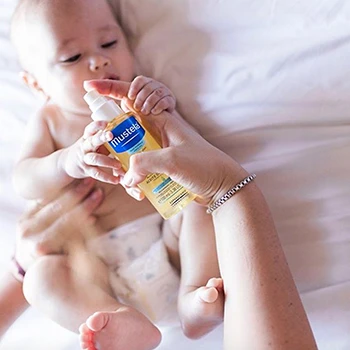
(Note: avoid essential oils, which have not been verified as safe for infants.)
9) Massage Your Baby’s Head
Giving your baby a very gentle head massage will soothe them and help to remove dead skin cells at the same time. Using your fingertips, simply rub along the surface of your baby’s dry scalp.
Remember to do this as gently as possible, since your baby’s skull is not yet fully developed.
Speaking of massaging your baby, if you’ve never given them a baby massage, try it out! The benefits are many, including reduced gas in colicky infants, a healthier immune system, and better sleep.
To learn how to give a baby massage, check out our article here.
10) Gently Brush Your Baby’s Dry Scalp
Similarly to a head massage, brushing your baby’s head will help to remove dead skin cells from your little one’s dry scalp. As the dead skin cells fall off, younger and healthier skin cells are able to rise to the surface of your baby’s skin.
Always use a baby brush with soft bristles. And, who knows, you may find that your baby loves having their scalp brushed!

11) Head To The Doctor’s Office
If your baby has a dry scalp or cradle cap that lasts more than a week, it’s best to talk to a pediatrician. You should also head to the doctor’s office if your baby seems to be in pain. As always, check with a pediatrician before giving your child any medications.
Say Goodbye To Your Baby’s Dry Scalp And Cradle Cap
You love your child more than anything in the world, so it can be concerning to notice they have dry scalp or cradle cap. Just remember that these conditions are not contagious, have nothing to do with hygiene, and are almost certainly not causing your child any discomfort.
Simply follow the 11 tips above and use Mustela’s line of gentle, natural, and safe products, like Foam Shampoo For Newborns and Cradle Cap Cream. Your baby’s scalp will be back to normal in no time!


